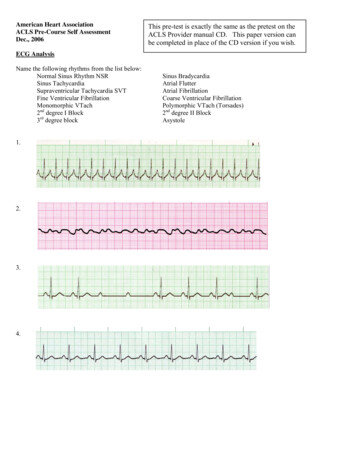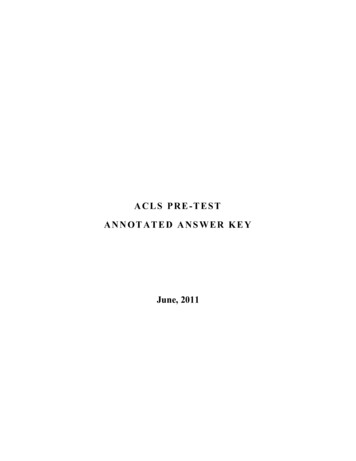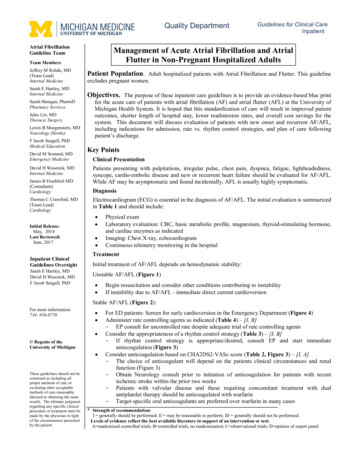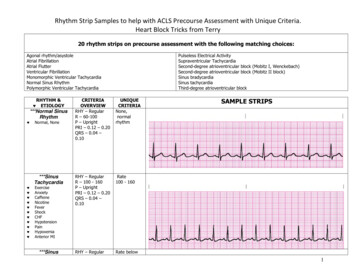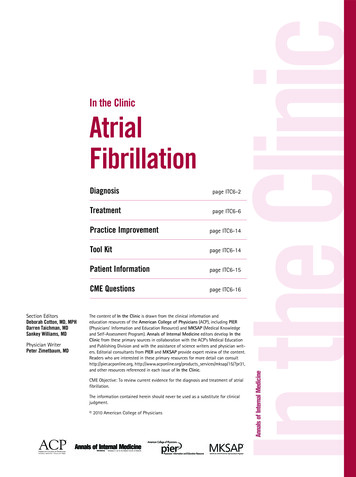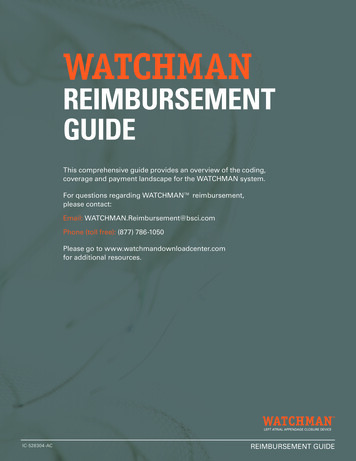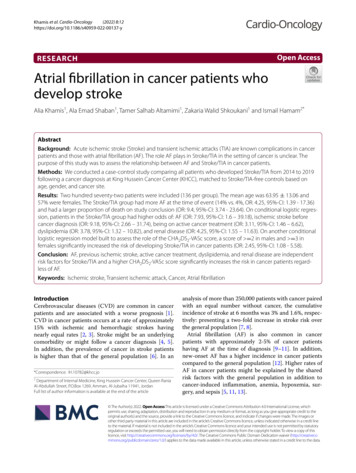
Transcription
(2022) 8:12Khamis et al. 00137-yOpen AccessRESEARCHAtrial fibrillation in cancer patients whodevelop strokeAlia Khamis1, Ala Emad Shaban1, Tamer Salhab Altamimi1, Zakaria Walid Shkoukani1 and Ismail Hamam2*AbstractBackground: Acute ischemic stroke (Stroke) and transient ischemic attacks (TIA) are known complications in cancerpatients and those with atrial fibrillation (AF). The role AF plays in Stroke/TIA in the setting of cancer is unclear. Thepurpose of this study was to assess the relationship between AF and Stroke/TIA in cancer patients.Methods: We conducted a case-control study comparing all patients who developed Stroke/TIA from 2014 to 2019following a cancer diagnosis at King Hussein Cancer Center (KHCC), matched to Stroke/TIA-free controls based onage, gender, and cancer site.Results: Two hundred seventy-two patients were included (136 per group). The mean age was 63.95 13.06 and57% were females. The Stroke/TIA group had more AF at the time of event (14% vs. 4%, OR: 4.25, 95%-CI: 1.39 - 17.36)and had a larger proportion of death on study conclusion (OR: 9.4, 95%-CI: 3.74 - 23.64). On conditional logistic regression, patients in the Stroke/TIA group had higher odds of: AF (OR: 7.93, 95%-CI: 1.6 – 39.18), ischemic stroke beforecancer diagnosis (OR: 9.18, 95%-CI: 2.66 – 31.74), being on active cancer treatment (OR: 3.11, 95%-CI: 1.46 – 6.62),dyslipidemia (OR: 3.78, 95%-CI: 1.32 – 10.82), and renal disease (OR: 4.25, 95%-CI: 1.55 – 11.63). On another conditionallogistic regression model built to assess the role of the CHA2DS2-VASc score, a score of 2 in males and 3 infemales significantly increased the risk of developing Stroke/TIA in cancer patients (OR: 2.45, 95%-CI: 1.08 - 5.58).Conclusion: AF, previous ischemic stroke, active cancer treatment, dyslipidemia, and renal disease are independentrisk factors for Stroke/TIA and a higher CHA2DS2-VASc score significantly increases the risk in cancer patients regardless of AF.Keywords: Ischemic stroke, Transient ischemic attack, Cancer, Atrial fibrillationIntroductionCerebrovascular diseases (CVD) are common in cancerpatients and are associated with a worse prognosis [1].CVD in cancer patients occurs at a rate of approximately15% with ischemic and hemorrhagic strokes havingnearly equal rates [2, 3]. Stroke might be an underlyingcomorbidity or might follow a cancer diagnosis [4, 5].In addition, the prevalence of cancer in stroke patientsis higher than that of the general population [6]. In an*Correspondence: IH.10782@khcc.jo2Department of Internal Medicine, King Hussein Cancer Center, Queen RaniaAl‑Abdullah Street, P.O.Box 1269, Amman, Al‑Jubaiha 11941, JordanFull list of author information is available at the end of the articleanalysis of more than 250,000 patients with cancer pairedwith an equal number without cancer, the cumulativeincidence of stroke at 6 months was 3% and 1.6%, respectively: presenting a two-fold increase in stroke risk overthe general population [7, 8].Atrial fibrillation (AF) is also common in cancerpatients with approximately 2-5% of cancer patientshaving AF at the time of diagnosis [9–11]. In addition,new-onset AF has a higher incidence in cancer patientscompared to the general population [12]. Higher rates ofAF in cancer patients might be explained by the sharedrisk factors with the general population in addition tocancer-induced inflammation, anemia, hypoxemia, surgery, and sepsis [5, 11, 13]. The Author(s) 2022. Open Access This article is licensed under a Creative Commons Attribution 4.0 International License, whichpermits use, sharing, adaptation, distribution and reproduction in any medium or format, as long as you give appropriate credit to theoriginal author(s) and the source, provide a link to the Creative Commons licence, and indicate if changes were made. The images orother third party material in this article are included in the article’s Creative Commons licence, unless indicated otherwise in a credit lineto the material. If material is not included in the article’s Creative Commons licence and your intended use is not permitted by statutoryregulation or exceeds the permitted use, you will need to obtain permission directly from the copyright holder. To view a copy of thislicence, visit http:// creat iveco mmons. org/ licen ses/ by/4. 0/. The Creative Commons Public Domain Dedication waiver (http:// creat iveco mmons. org/ publi cdoma in/ zero/1. 0/) applies to the data made available in this article, unless otherwise stated in a credit line to the data.
Khamis et al. Cardio-Oncology(2022) 8:12Page 2 of 8Acute ischemic stroke (Stroke) and transient ischemicattacks (TIA) are known complications in both cancerpatients and patients with AF but only until recently, therelationship observed between AF and cancer was limited to epidemiologic data showing that the diagnosis ofeither one increases the odds of being diagnosed withthe other. Nonetheless, the risk of stroke in patients withconcurrent cancer and AF is unclear and still needs moreevidence.The risk of thromboembolic events is assessed in eachpatient suffering from AF and the CHA2DS2-VASc scoreis the most common scheme used to do so. However,since cancer patients are generally assumed to have anincreased risk of thromboembolism, this might affect therisk of stroke in patients with cancer and AF. Furthermore, patients with active cancer were not included intrials that validated CHA2DS2-VASc as a stroke prediction score [10, 14, 15] rendering the role of this score inpredicting stroke risk in cancer patients unclear.In this study, we aim to evaluate the role of AF in thedevelopment of Stroke/TIA in cancer patients. Other riskfactors of Stroke/TIA are also investigated. Finally, therole of CHA2DS2-VASc in predicting Stroke/TIA in cancer patients is studied.developed Stroke/TIA between 2014 and 2019. Stroke/TIA diagnosis was either made by brain imaging or clinical evaluation at the time of the event by the followingphysician inside the center. Controls were retrievedbased on the matched characteristics from the database.Patients were not included if they had hemorrhagicstroke, infarction caused by brain metastasis, multiple concurrent cancers, or unconfirmed Stroke/TIAdiagnosis.Collected data included details related to age, gender,cancer type, cancer stage, cardiac rhythm on presentation, comorbidities, chemotherapy, radiotherapy, hormonal therapy, cancer-related surgery, use of anticoagulants,anti-platelets, and outcome. In addition, this informationwas utilized to calculate the CHA2DS2-VASc and HASBLED scores for each participant. Definitions of eachvariable are presented in the supplement.The primary outcome of our study was to examinethe presence of AF as an independent risk factor forStroke/TIA in cancer patients. The secondary outcomesincluded examination of the associations of clinical characteristics, treatment, and risk-stratifying scores withStroke/TIA in cancer patients.MethodsStatistical analysisEthical conduct of researchThis study was approved by the Institutional ReviewBoard committee at King Hussein Cancer Center. Allprocedures performed in this study involving human participants were in accordance with the ethical standards ofthe institutional research committee and with the 1964Helsinki declaration and its later amendments or comparable ethical standards. This article does not containany studies on animals performed by any of the authors.Informed consent was waived by the Institutional ReviewBoard committee due to the retrospective nature of thestudy.Study protocolWe conducted a matched case-control study. Cases whodeveloped Stroke/TIA from 2014 to 2019 following acancer diagnosis at King Hussein Cancer Center werematched to the controls who had cancer but did notdevelop Stroke/TIA up to the last day of follow up. Thecases were individually matched to the controls on a 1:1ratio based on age, gender, and site of cancer. All relevantpatient information was retrieved retrospectively fromelectronic medical records.All patient records were screened using automaticsearch. Cases were consecutively included if theyStatistical analysis was conducted using RStudio Version 1.3.1093. Categorical variables were presented asfrequencies and percentages while quantitative variables were expressed as median and interquartile range(IQR). Due to the study design of 1:1 individual matching of cases to controls, matched analyses were adapted.Univariate analyses were carried out to assess the differences/associations between Stroke/TIA patientsand their matched controls using the Wilcoxon test forcontinuous variables and McNemar’s test with continuity correction or exact test for categorical variables in2x2 tables. Categorical variables with 3x3 tables wereanalyzed using McNemar-Bowker Test. A level of significance 0.05 was set for all univariate analyses. Inaddition, a subgroup analysis of specific cancer types wasperformed using an exact test. Next, a conditional logisticregression model was built including variables that had ap-value 0.2 in the univariate analyses. Variables witha sample size below 25 were excluded from the model.In addition, variance inflation factor (VIF) level of 5and tolerance of 0.2 were set to detect multicollinearvariables; however, none of the variables had VIF higherthan 5. All the variables which fit the inclusion criteriaof the model were found to be categorical. Furthermore,another conditional logistic regression model was built to
Khamis et al. Cardio-Oncology(2022) 8:12Page 3 of 8assess the effect of the CHA2DS2-VASc score. Variablesthat were included in computing C HA2DS2-VASc scorewere excluded from the model. A level of significance 0.05 was set for both regression models.ResultsA total of 272 cancer patients divided into 136 Stroke/TIA patients were matched to 136 controls withoutStroke/TIA. Table 1 summarizes the matched characteristics between the 2 groups, while Table 2 summarizesunivariate associations.Patients were 63 13.06 years of age and predominantly females (57%). The four most common cancersites encountered were gastrointestinal tract (24%),breast (15%), lung and pleura (15%), and urological (13%)tumors. In addition, 90% of patients had at least one concomitant comorbidity and 12% of the patients who hadStroke/ TIA had a second Stroke/TIA within one year ofthe first event.Univariate analyses (Table 2) revealed significantassociations among the following variables comparing Stroke/TIA to their controls, respectively: beingon active cancer-specific treatment (44% vs. 25%,p-value 0.002) which had a matched OR (95%CI) of 2.9 (1.36 – 3.89) representing higher odds ofbeing on active treatment in Stroke/TIA patients ofthe discordant pairs, having AF (14% vs. 4%, p-value 0.007) with a matched OR (95% CI) of 4.25 (1.39- 17.36), having at least one comorbidity (96% vs.85%, p-value 0.002) with a matched OR (95% CI)of 5 (1.68 - 20.12), having hypertension (65% vs.52%, p-value 0.030) with a matched OR (95% CI)of 1.86 (1.09 - 5.31), having diabetes mellitus (47%vs. 35%, p-value 0.040) with a matched OR (95%Table 1 Matched characteristics of patientsVariableTotal(n 272)Stroke/TIA(n 136)No Stroke/TIA(n 136)Age63.95 13.0663.93 13.1863.98 12.99Gastrointestinal Tract66 (24%)33 (24%)33 (24%)Breast40 (15%)20 (15%)20 (15%)Lung and Pleura40 (15%)20 (15%)20 (15%)Urological34 (12%)17 (12%)17 (12%)Head and Neck30 (11%)15 (11%)15 (11%)Hematological28 (10%)14 (10%)14 (10%)Gynecological22 (8%)11 (8%)11 (8%)Intracranial8 (3%)4 (3%)4 (3%)Bone2 (1%)1 (1%)1 (1%)Others2 (1%)1 (1%)1 (1%)Male118 (43%)59 (43%)59 (43%)Cancer SiteCI) of 1.77 (1.05 – 2.99), having dyslipidemia (34%vs. 16%, p-value 0.001) with a matched OR (95%CI) of 3.67 (1.75 - 7.66), having renal disease (29%vs. 12%, p-value 0.001) with a matched OR (95%CI) of 4 (1.84 - 8.68), having a history of previousischemic stroke before cancer diagnosis (29% vs. 3%,p-value 0.001) with a matched OR (95% CI) of 9.75(3.48 - 27.25), having coronary artery disease (25%vs. 13%, p-value 0.020) with a matched OR (95%CI) of 2.23 (1.16 - 4.29), and having congestive heartfailure (8% vs. 2%, p-value 0.020) with a matchedOR (95% CI) of 5.5 (1.2 - 51.07). In addition, univariate analyses revealed significant associations among C HA2DS2-VASc and HAS-BLED scores. Proportionsof patients who had a C HA2DS2-VASc score above orequal 2 in males and above or equal 3 in females were71% of Stroke/TIA patients vs. 52% of their controls,p-value 0.001 with a matched OR (95% CI) of 3.08(1.61 – 5.91). Proportions of patients who had HASBLED score above or equal 3 were 45% of Stroke/TIApatients vs. 23% of their controls, p-value 0.001 witha matched OR (95% CI) of 4.33 (2.1 - 8.95). Finally,proportions of patients who died at the time of studyconclusion were 76% in Stroke/TIA patients vs. 33%in their controls, p-value 0.001 with a matched OR(95% CI) of 9.4 (3.74 - 23.64).The role of CHA2DS2-VASc score was further analyzedonly in patients who did not have AF. In the patients whohad stroke/TIA without AF, 77 (68.1%) patient had ascore above or equal 2 in males and above or equal 3 infemales while in the patient who did not have stroke/TIAand were not to know to have AF, 56 (49.1%) patients hada similar score, P-value 0.001.Multivariate analysis was carried out using conditionallogistic regression to study the effects of the aforementioned variables on the likelihood of having Stroke/TIA.Congestive heart failure was excluded from the modeldue to low sample size. The regression model was statistically significant with a likelihood test of χ2 (13) 70.04,p-value 0.001 and a concordance of 0.78 (SE 0.05).The following variables were statistically significant:active cancer treatment (p-value 0.003), AF (p-value 0.010), dyslipidemia (p-value 0.010), renal disease(p-value 0.005), and history of previous ischemicstroke before cancer diagnosis (p-value 0.001). All thesevariables increased the risk of developing Stroke/TIAwith history of previous ischemic stroke (OR 9.18, 95%CI 2.66 - 31.74) and AF (OR 7.93, 95% CI 1.6 39.18) having the higher odds (Table 3) (Fig. 1).In addition, another conditional logistic regression model was built to assess the effect of the CHA2DS2-VASc score on the likelihood of having Stroke/
Khamis et al. Cardio-Oncology(2022) 8:12Page 4 of 8Table 2 Univariate analysis of patients’ clinical characteristicsVariableTotal(n 272)Stroke/TIA(n 136)No Stroke/TIA(n 136)p-value.320Cancer StageLocalized59 (22%)26 (19%)33 (24%)Regional49 (18%)21 (15%)28 (21%)Distant125 (46%)69 (51%)56 (41%)Unstageable39 (14%)20 (15%)19 (14%)94 (35%)60 (44%)34 (25%)Cancer-Specific ManagementActive Cancer Treatment at The Time of Event(Stroke/TIA).002History of Chemotherapy161 (59%)83 (61%)78 (57%).600History of Hormonal Therapy32 (12%)13 (10%)19 (14%).140History of Radiotherapy108 (40%)56 (41%)52 (38%).670History of Cancer-Related Surgery125/ 266 (47%)57 (42%)68/ 130 (52%).07025 (9%)19 (14%)6 (4%).007Atrial Fibrillation(New onset AF or baseline AF)ComorbiditiesAny246 (90%)131 (96%)115 (85%).002Hypertension158 (58%)88 (65%)70 (52%).030Diabetes MellitusSmoking111 (41%)64 (47%)47 (35%).040Smoker 88 (32%)Ex-smoker 43 (16%)Smoker 45 (33%)Ex-Smoker 22 (16%)Smoker 43 (32%)Ex-smoker 21 (15%).950Dyslipidemia68 (25%)46 (34%)22 (16%) .001Renal Disease56 (21%)40 (29%)16 (12%) .001Coronary Artery Disease52 (19%)34 (25%)18 (13%).020Previous Ischemic Stroke(Before Cancer Diagnosis)43 (16%)39 (29%)4 (3%) .001Vascular Disease39 (14%)25 (18%)14 (10%).080Hypothyroidism28 (10%)16 (12%)12 (9%).560Congestive Heart Failure13 (4%)11 (8%)2 (2%).020105 (39%)40 (29%)65 (48%) .001167 (61%)96 (71%)71 (52%)CHA2DS2-VASc(groups)Male 2Female 3Male 2Female 3HAS-BLED(groups) 3180 (66%)75 (55%)105 (77%) 392 (34%)61 (45%)31 (23%) .001Anticoagulation Therapy39 (14%)24 (18%)15 (11%).190Antiplatelet Therapy68 (25%)39 (29%)29 (21%).170Death (at the time of study conclusion)148 (54%)103 (76%)45 (33%) .001
Khamis et al. Cardio-Oncology(2022) 8:12Page 5 of 8Table 3 Conditional logistic regression model of stroke/TIA risk factorsVariableBS.E.WaldOdds Ratio95% CI for Odds Ratiop-valueActive Cancer Treatment at The Time of Event (Stroke/TIA)1.130.398.73.111.46 - 6.62.003History of Hormonal Therapy-1.460.882.80.230.04 - 1.29.100History of Cancer-Related Surgery-0.130.420.090.880.39 - 1.99.760Atrial Fibrillation(New onset AF or baseline AF)2.070.826.47.931.6 - 39.18.010Coronary Artery Disease0.680.621.21.970.59 - 6.6.270Diabetes-0.500.471.10.60.24 - 1.52.280Dyslipidemia1.330.546.13.781.32 - 10.82.010Hypertension0.510.411.51.670.74 - 3.74.220Vascular Disease-0.280.610.210.760.23 - 2.51.650Renal Disease1.480.518.04.251.55 - 11.63.005Previous Ischemic Stroke (Before Cancer Diagnosis)2.220.6312.39.182.66 - 31.74 .001Anticoagulation Therapy-0.520.51.10.60.23 - 1.58.300Antiplatelet Therapy-0.320.490.410.730.28 - 1.92.520Fig. 1 Forest Plot of Analysis of Multiple Clinical Variables and the Likelihood of stroke/TIA Occurring in Cancer Patients. Multivariate analysis wascarried out using conditional logistic regression to study the effects of the clinical variables on the likelihood of having Stroke/TIA. The pointsrepresent the Odds Ratio, and the lines represent the 95% confidence interval. Points in blue represent an OR 1 indicating that cases withStroke/TIA are more likely to have the corresponding clinical characteristic. Lines (CIs) which do not cross the null value of 1 represent statisticalsignificanceTIA in cancer patients. (Figure 2) Variables included incomputing the C HA2DS2-VASc score were excludedfrom the model. The model was statistically significantwith a likelihood test of χ2 (8) 46.85, p-value 0.001and a concordance of 0.71 (SE 0.06). The followingvariables significantly increased the risk of Stroke/TIA:having a CHA2DS2-VASc score of 2 in males and 3in females (p-value 0.030), active cancer treatment(p-value 0.001), dyslipidemia (p-value 0.046), andrenal disease (p-value 0.003) (Fig. 2).
Khamis et al. Cardio-Oncology(2022) 8:12Page 6 of 8Fig. 2 Forest plot representing CHA2DS2-VASc score contribution to Stroke/TIA in cancer patients. Another conditional logistic regression modelwas built to assess the effect of the CHA2DS2-VASc score on the likelihood of having Stroke/TIA in cancer patients. Variables included in computingthe CHA2DS2-VASc score were excluded from the model. A CHA2DS2-VASc score of 2 in males and 3 in females significantly increases therisk of Stroke/TIA in cancer patients independent of AF diagnosis. The points represent the Odds Ratio, and the lines represent the 95% confidenceinterval. Points in blue represent an OR 1 indicating that cases with Stroke/TIA are more likely to have the corresponding clinical characteristic.Lines (CIs) which do not cross the null value of 1 represent statistical significanceDiscussionAlthough the association between AF and cancer hasbeen extensively studied before [5, 9–13], the associationbetween AF and Stroke/TIA in the setting of cancer, onthe contrary, has not. Several studies have investigatedthe risk factors for developing Stroke/TIA in cancer andnon-cancer patients and found that classical risk factorsand stroke patterns were comparable in both groups ofpatients. However, up to our knowledge, this is the firststudy that compared cancer patients who developedStroke/TIA to a control group of cancer patients withoutStroke/TIA with the same age, gender, type of cancer andwere managed at the same facility within the same timeframe [16–20].We hypothesized that since both AF and cancer areindependently associated with an increased risk of stroke,this risk should increase in the setting of concurrent AFand cancer. In our study, we retrospectively assessed allconsecutive patients who developed ischemic Stroke/TIAat our institution over the span of 5 years; and found thatamong the 136 patients who developed Stroke/TIA, 14% had AF (new onset or at baseline) which significantlyand independently correlates to the likelihood to developStroke/TIA in cancer patients. Similar findings in a largecohort study by Hu et al showed that cancer patientswho developed AF, compared to those who did not, hada significantly higher risk of thromboembolism includingstrokes [9].The correlation between the C HA2DS2-VASc scoreand stroke risk was previously described by Patelland his colleagues [10]. They concluded that in cancer patients with preexisting AF, a higher CHADS2and C HA2DS2-VASc score were both associated withincreased risk of ischemic stroke. In our study, weincluded consecutive cancer patients who developed Stroke/TIA regardless of their AF status, cancertype, duration, or stage; and we assessed the utility of C HA2DS2-VASc to predict Stroke/TIA in all patientseven if they didn’t have any evidence of documentedAF. Moreover, we included the C HA2DS2-VAScscore instead of the C HADS2 score given its increasing importance in the assessment of stroke risk inpatients with AF. We hypothesized that since manycomponents of the C HA2DS2-VASc score such as heart
Khamis et al. Cardio-Oncology(2022) 8:12Page 7 of 8failure, hypertension, old age, and diabetes mellituswere found to be associated with stroke in the generalpopulation [21, 22]; this score would predict the riskof stroke in cancer patients regardless of the presenceof AF. We found that proportions of patients who hadStroke/TIA and a high C HA2DS2-VASc score (of 2in males and 3 in females) regardless of AF diagnosis are larger than those of their pairs in the control group who did not develop Stroke/TIA (71% vs.52%, p-value 0.001 with a matched OR (95% CI) of3.08 (1.61 – 5.91). In addition to the C HA2DS2-VAScscore, renal disease, dyslipidemia, and being on activecancer treatment significantly predict Stroke/TIA incancer patients. These findings will raise questionsregarding the benefit of adding more variables to the C HA2DS2-VASc score or the possibility of inventinganother scheme that can predict Stroke/TIA in cancerpatients to apply preventive measures.In our study, we found that those with a history ofprevious ischemic stroke or AF have higher odds ofdeveloping Stroke/TIA independently from many otherfactors that are attributed to cancer itself. This finding isunique among many studies where atherosclerosis andvascular risk factors remain the most common risk factors of stroke in cancer and non-cancer patients [16, 17].Finally, we found that cancer patients who developedStroke/TIA when compared to patients without Stroke/TIA are more likely to die after an Stroke/TIA diagnosis.Similar findings were concluded before by several clinical studies [2, 8, 23, 24] stating that the prognosis may beworse in patients with cancer and stroke, due to reducedgeneral health and the prognosis of cancer itself. Thisreflects the need for clinicians to be aware of the impactof these events on mortality.Based on these results, prevention of Stroke/TIA incancer patients should be based on assessing these riskfactors. Preventive measures should be considered whileaccounting for the increased risk of bleeding, as ourstudy found that patients in the Stroke/TIA group had asignificantly higher HAS-BLED score. To date, a specificapproach to prevent Stroke/TIA in cancer patients hasnot yet been established; demanding the need for futurestudies to prospectively validate these findings and establish a cancer-specific stroke prediction score.were created, and special care was taken in collecting andreviewing the data by our team. Another limitation in ourstudy is the relatively small number of patients, despitethe inclusion of all patients who developed Stroke/TIAover a period of 5 years. This is attributed to restrictingthe inclusion of patients only to those subjected to sufficient evaluation which concluded a definitive diagnosis of ischemic Stroke/TIA. Furthermore, patients witha vague diagnosis or patients with brain hemorrhage orbrain metastasis were excluded.Study limitationsFundingAll authors have reported that they have no relationships relevant to thecontents of this paper to disclose.Our study is subject to the same limitations as other retrospective studies involving chart-reviewing due to thenature of the data entered into the electronic medicalrecords which was not pre-designed for clinical researchpurposes. However, special algorithms and databasesConclusionThis is a single-center matched case-control study ofcancer patients who developed Stroke/TIA with theirmatched cancer patients without Stroke/TIA. Wefound that having new-onset or history of AF, previous ischemic stroke, active cancer treatment, dyslipidemia, and kidney disease are independent risk factorsfor Stroke/TIA in cancer patients. In addition, havinga high C HA2DS2-VASc score of 2 in males and 3in females significantly increases the risk of Stroke/TIAin cancer patients independent of AF diagnosis. Thesepatients are more likely to have to have AF at the timeof event and to die earlier than their matched controls.AbbreviationsCVD: Cerebrovascular Disease; AF: Atrial Fibrillation; Stroke: Acute IschemicStroke; TIA: Transient Ischemic Attack.Supplementary InformationThe online version contains supplementary material available at https:// doi. org/ 10. 1186/ s40959- 022- 00137-y.Additional file 1.AcknowledgmentsThe authors would like to acknowledge Wisam Hmaidi for data coding andacquisition and Dalia Rimawi for her intellectual contributions to our study.Funding support and author disclosuresAll authors have reported that they have no relationships relevant to thecontents of this paper to disclose.Authors’ contributionsI.H and A.K participated in conception and design of the manuscript, draftingof the manuscript and revising the manuscript critically for important intellectual content. A.K, A.S, T.A and Z.S participated in data collection, analysisand interpretation of data. All authors read and approved the final manuscript.I.H worked on the manuscript submission.Availability of data and materialsThe datasets used and/or analyzed during the current study are availablefrom the corresponding author on reasonable request. This is subject to theinstitutional data sharing policy.
Khamis et al. Cardio-Oncology(2022) 8:12DeclarationsEthics approval and consent to participateThis study was approved by the Institutional Review Board committee atKing Hussein Cancer Center. All procedures performed in this study involvinghuman participants were in accordance with the ethical standards of theinstitutional research committee and with the 1964 Helsinki declaration andits later amendments or comparable ethical standards. This article does notcontain any studies on animals performed by any of the authors. Informedconsent was waived by the Institutional Review Board committee due to theretrospective nature of the study.Consent for publicationNot applicable.Competing interestsThe authors declare that they have no competing interests.Author details1Office of Scientific Affairs and Research, King Hussein Cancer Center, Amman,Jordan. 2 Department of Internal Medicine, King Hussein Cancer Center, QueenRania Al‑Abdullah Street, P.O.Box 1269, Amman, Al‑Jubaiha 11941, Jordan.Received: 27 January 2022 Accepted: 18 April 2022Page 8 of 816. Cestari DM, Weine DM, Panageas KS, Segal AZ, DeAngelis LM.Stroke in patients with cancer: incidence and etiology. Neurology.2004;62:2025–30.17. Nguyen T, DeAngelis LM. Stroke in cancer patients. Curr Neurol NeurosciRep. 2006;6:187–92.18. Rogers LR. Cerebrovascular complications in cancer patients. Neurol Clin.2003;21:167–92.19. Zhang YY, Cordato D, Shen Q, Sheng AZ, Hung WT, Chan DK. Risk factor,pattern, etiology and outcome in ischemic stroke patients with cancer: anested case-control study. Cerebrovasc Dis. 2007;23:181–7.20. Zhang YY, Chan DK, Cordato D, Shen Q, Sheng AZ. Stroke risk factor, pattern and outcome in patients with cancer. Acta Neurol Scand.2006;114:378–83.21. Lehto S, Rönnemaa T, Pyörälä K, Laakso M. Predictors of Stroke inMiddle-Aged Patients With Non–Insulin-Dependent Diabetes. Stroke.1996;27:63–8.22. Himmelmann A, Hansson L, Svensson A, Harmsen P, Holmgren C,Svanborg A. Predictors of Stroke in the Elderly. Acta Medica Scandinavica.1988;224:439–43.23. Sheng B, Fong MK, Chu YP, et al. Stroke and cancer: misfortunes nevercome singularly. Int J Stroke. 2013;8:E30.24. Saposnik G, Kapral MK, Liu Y, et al. IScore: a risk score to predict deathearly after hospitalization for an acute ischemic stroke. Circulation.2011;123:739–49.Publisher’s NoteReferences1. Newton HB. Neurologic complications of systemic cancer. Am Fam Physician. 1999;59:878–86.2. Kneihsl M, Enzinger C, Wünsch G, et al. Poor short-term outcomein patients with ischaemic stroke and active cancer. J Neurol.2016;263:150–6.3. Grisold W, Oberndorfer S, Struhal W. Stroke and cancer: a review. ActaNeurol Scand. 2009;119:1–16.4. Arboix A. Cerebrovascular disease in the cancer patient. Rev Neurol.2000;31:1250–2.5. Mery B, Guichard JB, Guy JB, et al. Atrial fibrillation in cancer patients:Hindsight, insight and foresight. Int J Cardiol. 2017;240:196–202.6. Selvik HA, Thomassen L, Logallo N, Næss H. Prior cancer in patients withischemic stroke: the Bergen NORSTROKE study. J Stroke Cerebrovasc Dis.2014;23:919–25.7. Navi BB, Reiner AS, Kamel H, et al. Risk of Arterial Thromboembolism inPatients With Cancer. J Am Coll Cardiol. 2017;70:926–38.8. Navi BB, Iadecola C. Ischemic stroke in cancer patients: A review of anunderappreciated pathology. Ann Neurol. 2018;83:873–83.9. Hu YF, Liu CJ, Chang PM, et al. Incident thromboembolism and heartfailure associated with new-onset atrial fibrillation in cancer patients. Int JCardiol. 2013;165:355–7.10. Patell R, Gutierrez A, Rybicki L, Khorana AA. Usefulness of CHADS2 andCHA2DS2-VASc Scores for Stroke Prediction in Patie
Stroke/ TIA had a second Stroke/TIA within one year of the rst event. Univariate analyses (Table 2) revealed significant associations among the following variables compar-ing Stroke/TIA to their controls, respectively: being on active cancer-specific treatment (44% vs. 25%, p-value 0.002) which had a matched OR (95%
